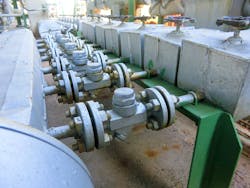Energy Saver: Tips for Effective Steam Trap Maintenance
Steam traps play a crucial role in maintaining efficient operation of steam systems in oil refineries and petrochemical plants. These devices remove condensate and non-condensable gases from steam lines to ensure optimal heat transfer in steam users such as heaters, boilers and steam-tracing. They also prevent energy waste. Let’s dive into the design, use and maintenance of steam traps and look at examples of the costs associated with energy waste and operational issues related to steam trap failures.
Design of Steam Traps
When designing steam traps, key considerations include the steam system’s pressure and temperature. Various types of steam traps, including mechanical, thermostatic and thermodynamic traps, are available to meet the specific requirements of process plants. Proper sizing and selection of steam traps are essential to ensure efficient condensate removal while minimizing steam loss. The four types of steam traps to consider include:
Thermostatic (operated by changes in fluid temperature). The temperature of saturated steam is determined by its pressure. When condensate and saturated steam reach the steam trap, the condensate cools. A thermostatic trap passes condensate when this lower temperature is sensed. As steam reaches the trap, the temperature rises and the trap closes.
Mechanical (operated by changes in fluid density). This range of steam traps operates by sensing the difference in density between steam and condensate. These steam traps include ball float traps and inverted bucket traps. In the ball float trap, the ball rises in the presence of condensate, opening a valve and passing the denser condensate. With the inverted bucket trap, the inverted bucket floats when steam reaches the trap and rises to shut the valve. Both are essentially mechanical in their method of operation.
Thermodynamic (operated by changes in fluid dynamics). Thermodynamic steam traps rely partly on the formation of flash steam from condensate. This group includes thermodynamic, disc, impulse and labyrinth steam traps.
Fixed orifice traps. These traps can’t be considered automatic devices as they are simply a fixed diameter hole set to pass a calculated amount of condensate and steam under one set of conditions.
In all these traps, hot condensate escapes under dynamic pressure and releases a mixture of steam and water.
Energy waste resulting from non-functioning or inefficient steam traps can have significant financial implications.
Use of Steam Traps
Steam traps are strategically installed throughout the steam system in oil refineries and petrochemical plants to effectively remove condensate. These devices work by using different mechanisms to detect and discharge condensate, while preventing steam escape. By maintaining an optimal steam-to-condensate ratio, steam traps help conserve energy and minimize operational costs. Most steam traps are typically associated with steam tracing lines, which maintain process piping and equipment temperatures even when not in use.
During plant visits, I frequently find many non-functioning steam traps. This situation is often attributed to lack of maintenance, trap blockages or significant corrosion. In response, operators generally open a bypass valve around the steam trap and vent an unnecessarily high amount of steam, while draining the condensate to the ground. This is a waste of condensate (that can be reused in the boilers) and steam vented into the air. For instance, a mid-size oil refinery in a cold climate typically has 5,000 to 20,000 steam traps that can result in significant energy waste.
Maintenance of Steam Traps
When I visit a plant and see a high rate of failed steam traps, I usually recommend implementing a dedicated maintenance program to address all steam traps on an annual basis. The size of this maintenance team depends on the number of traps, varying from two to five people.
The payback for such a program typically ranges between two and five months, not considering the operational improvements.
Typical maintenance tasks include checking for leaks, cleaning or replacing strainers and verifying the correct operation of trap mechanisms. Instruments such as an infrared digital imaging thermometer can be very helpful in identifying failed steam traps.
Cost of Energy Waste
Energy waste resulting from non-functioning or inefficient steam traps can have significant financial implications for process plants. When steam traps fail, condensate accumulates in steam lines, reducing heat transfer efficiency. This leads to increased fuel consumption and operating costs while decreasing overall productivity. Additionally, the excess condensate can cause water hammer, pipe damage and potential safety hazards.
Practical plant experience and steam trap surveys in oil refineries show roughly 20 to 40 lb/h of steam typically is lost per one failed steam trap. With an average annual failure rate of 10% for steam traps in the oil refinery service, a lack of systematic steam trap maintenance could lead to half of the refinery’s traps becoming nonfunctional after five years.
Assuming a 50% failure rate among 5,000 steam traps in the refinery, the total steam loss would reach 50 klb/h at 20 lb/h per manufacturing. At a conservative steam cost of 5 $/klb, this leads to an annual cost of $2 million for the oil refinery.
Operational Issues When Steam Traps Fail
- Reduced Heat Transfer Efficiency. Inefficient steam traps allow condensate to accumulate, reducing the system’s heat transfer capability. This situation results in processes requiring longer heating and cooling times, leading to decreased productivity with increased operational costs.
- Steam Loss. Failed steam traps allow steam to escape, leading to increased energy consumption to maintain the desired steam pressure as discussed in the previous paragraph. This condition produces higher fuel costs while reducing energy efficiency.
- Water Hammer. Non-functioning steam traps can cause water hammer, a phenomenon characterized by the sudden pressure surge in the steam system. This scenario can damage pipes, valves and other equipment, resulting in expensive repairs and unexpected downtime.
Conclusion
Steam traps are essential components in oil refineries and petrochemical plants. By removing condensate, they maintain the steam system’s efficiency. The costs associated with non-functioning steam traps include increased energy consumption, reduced productivity and potential equipment damage. Therefore, by prioritizing the design, use and maintenance of steam traps, refineries and petrochemical plants can reduce energy costs while optimizing operations and overall efficiency.
About the Author
Michiel Spoor, Energy Saver columnist
Energy Saver columnist
Michiel Spoor has over 28 years of energy experience, working worldwide as a leader in oil and gas consulting. He has a master’s degree in Chemical Process Technology from the Delft University of Technology in The Netherlands.
His passion is to shape the future of energy transition, renewables, global carbon emission reduction and energy efficiency. He has had diverse roles in engineering and consulting. He started his career as a process design engineer at Badger BV in The Hague where he brought plants from conceptual design, through process simulation, equipment designs all the way to commissioning and start-up.
As a consultant Michiel specializes in energy management and energy transition and has held senior positions in various companies like KBC, Accenture and KBR. Currently Michiel works as a Principal Consultant Energy with KBC Advanced Technology in Houston, Texas. He has worked on six continents on various projects and positions in oil refining, petrochemicals, fertilizers, LNG and renewables.
Michiel has authored and contributed to numerous papers and conferences on the topics of refinery energy efficiency and refinery carbon management. He is internationally recognized as an authority on this subject.

